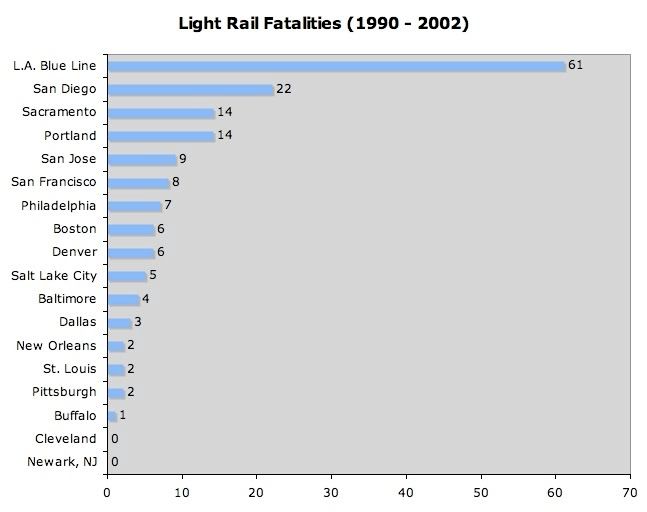In the wake of the tragic Chatsworth accident, Southern California's rail transit agencies have undergone increased scrutiny (for some inexplicable reason, the rail safety oversight body for the state, the California Public Utilities Commission, has been spared).
In so many categories, Metrolink (commuter rail) and MTA (light rail) have operated systems that even in comparison to their peers are far more deadly.
A comparison of the major commuter rail systems fatality rates from 1993 (the first full year of Metrolink operation) to 2007 (the most recent full year of Metrolink operation) from the Federal Railroad Administration Office of Safety Analysis database is below:

As mentioned in a previous post, in 2003, when USA Today compiled the American Public Transit Association statistics for light rail fatalities to compose their article, Blue Line takes a troubled route, in every category the Blue Line was the deadliest light rail system in the country. Here's a graph that compares light rail system deaths from 1990 (the Blue Line's first full year of operation) to 2002:

In an op-ed published in the LA Times titled "Rail Safety's Human Error Excuse," USC Professor Najmedin Meshkati, an internationally recognized expert in transportation system safety who testified on our behalf at the CPUC Evidentiary Hearing stated:
Are we to believe, for instance, that all crossing incidents were because of negligence when the death rate is so much higher here than almost any other place in the nation?
In the $30-40 billion dollar measure put on the ballot by MTA there is not one penny for grade separations on the Blue Line, additional grade separations on Phase 1 of the Expo Line, or Metrolink safety upgrades. The transportation measure that is intended to set the course of the MTA for the next 30 years and there is not one penny to fix the current problems.
The reality is the culture of MTA and Metrolink, which are governed by our region's politicians, does not value lives.